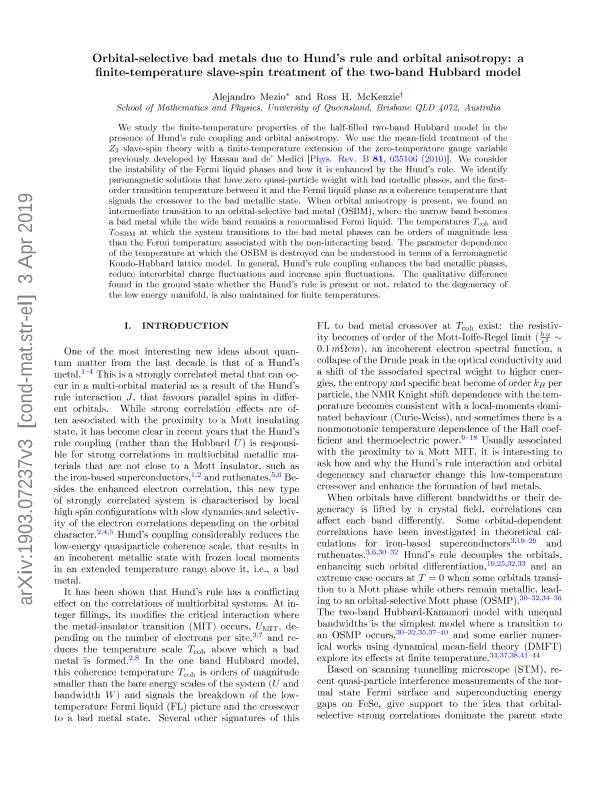Mostrar el registro sencillo del ítem
dc.contributor.author
Mezio, Alejandro

dc.contributor.author
McKenzie, Ross H.
dc.date.available
2022-01-04T18:59:13Z
dc.date.issued
2019-11
dc.identifier.citation
Mezio, Alejandro; McKenzie, Ross H.; Orbital-selective bad metals due to Hund’s rule and orbital anisotropy: A finite-temperature slave-spin treatment of the two-band Hubbard model; American Physical Society; Physical Review B: Condensed Matter and Materials Physics; 100; 20; 11-2019; 1-16
dc.identifier.issn
1098-0121
dc.identifier.uri
http://hdl.handle.net/11336/149593
dc.description.abstract
We study the finiteerature properties of the half-filled two-band Hubbard model in the presence of Hund's rule coupling and orbital anisotropy. We use the mean-field treatment of the Z2 slave-spin theory with a finiteerature extension of the zeroerature gauge variable previously developed by Hassan and de' Medici [Phys. Rev. B 81, 035106 (2010)10.1103/PhysRevB.81.035106]. We consider the instability of the Fermi-liquid phases and how it is enhanced by the Hund's rule. We identify paramagnetic solutions that have zero quasiparticle weight with a bad metal, and the first-order transition temperature between the bad metal and the Fermi-liquid phase as a coherence temperature that signals the crossover to the bad metallic state. When orbital anisotropy is present, we found an intermediate transition to an orbital-selective bad metal (OSBM), where the narrow band becomes a bad metal while the wide band remains a renormalized Fermi liquid. The temperatures Tcoh and TOSBM at which the system transitions to the bad metal phases can be orders of magnitude less than the Fermi temperature associated with the noninteracting band. The parameter dependence of the temperature at which the OSBM is destroyed can be understood in terms of a ferromagnetic Kondo-Hubbard lattice model. In general, Hund's rule coupling enhances the bad metallic phases, reduces interorbital charge fluctuations, and increases spin fluctuations. The qualitative difference found in the ground state whether the Hund's rule is present or not, related to the degeneracy of the low-energy manifold, is also maintained for finite temperatures.
dc.format
application/pdf
dc.language.iso
eng
dc.publisher
American Physical Society

dc.rights
info:eu-repo/semantics/openAccess
dc.rights.uri
https://creativecommons.org/licenses/by-nc-nd/2.5/ar/
dc.subject.classification
Física de los Materiales Condensados

dc.subject.classification
Ciencias Físicas

dc.subject.classification
CIENCIAS NATURALES Y EXACTAS

dc.title
Orbital-selective bad metals due to Hund’s rule and orbital anisotropy: A finite-temperature slave-spin treatment of the two-band Hubbard model
dc.type
info:eu-repo/semantics/article
dc.type
info:ar-repo/semantics/artículo
dc.type
info:eu-repo/semantics/publishedVersion
dc.date.updated
2020-11-19T21:56:33Z
dc.journal.volume
100
dc.journal.number
20
dc.journal.pagination
1-16
dc.journal.pais
Estados Unidos

dc.journal.ciudad
Washington D. C.
dc.description.fil
Fil: Mezio, Alejandro. Consejo Nacional de Investigaciones Científicas y Técnicas. Centro Científico Tecnológico Conicet - Rosario. Instituto de Física de Rosario. Universidad Nacional de Rosario. Instituto de Física de Rosario; Argentina. University of Queensland; Australia
dc.description.fil
Fil: McKenzie, Ross H.. University of Queensland; Australia
dc.journal.title
Physical Review B: Condensed Matter and Materials Physics

dc.relation.alternativeid
info:eu-repo/semantics/altIdentifier/url/https://journals.aps.org/prb/abstract/10.1103/PhysRevB.100.205134
dc.relation.alternativeid
info:eu-repo/semantics/altIdentifier/doi/http://dx.doi.org/10.1103/PhysRevB.100.205134
dc.relation.alternativeid
info:eu-repo/semantics/altIdentifier/url/https://arxiv.org/abs/1903.07237
Archivos asociados
